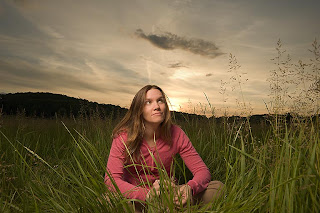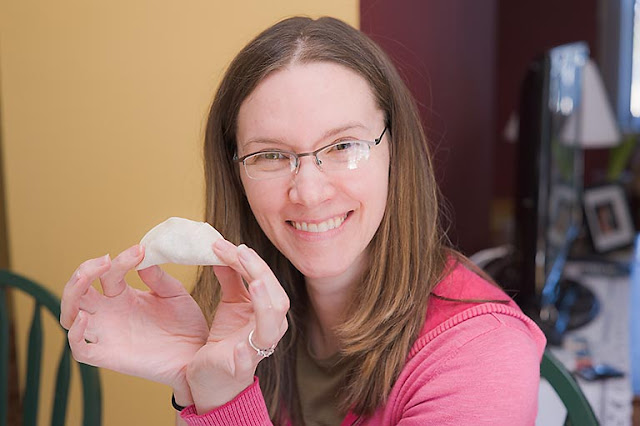 |
| Image Copyright Joe McNally |
A few elements that I wanted were an open scene with tall grasses, trees, and the sunset in the background with great skies and colors. I also wanted to shoot wide and use flash to add some dramatic lighting to my subject. I thought of a place and the weather for a good sunset looked to very likely so we set on out to Valley Forge National Park.
Rebecca and I brought along our cameras, a couple of flash stands, umbrellas, and a 5-in-1 collapsible reflector. We've been to Valley Forge before so I had a good idea where I wanted to be in time for the sunset. We drove around a little, scouting a few other possible locations but ended up just where I first thought we'd be. We arrived just after 6pm so we had plenty of time to setup and prepare. Sunset wasn't until just after 8pm but the surrounding hills, trees, and some cloud cover would lessen the light considerably from about 7:30pm and on wards.
I first setup with the flash high overhead, shooting through an umbrella, pointing straight down. I metered the sky and found that I needed to shoot around f/16 and 1/250 at ISO 200 to get the sky where I wanted to. At this aperture and speed, the little SB-600 was working at full steam and then some probably. I had the SB-600 gelled with a 1/2 CTO so that along with the umbrella was really cutting down on the amount of light getting into the camera. I was shooting using iTTL as well and was set on full-matrix metering. Some test shots showed that while the sky looked pretty good, the light coming down on Rebecca and the surrounding area was just too much, too harsh. I tried to dial in some exposure compensation all the way down to -3 but that still didn't give me the results that I wanted. So I switched off from iTTL and went to manual and then experimented and tried to find the level of light that I wanted.
In hindsight, I should have used a 1-stop or 2-stop ND filter so I could open up my aperture. This may have allowed me to shoot without needing full power from the flash and would've controlled the sky. I should have also switched to spot-metering as well so iTTL didn't think it needed to light-up the whole scene evenly and fire the flash at full power.
We rolled with some photos and there were still a couple of things that I wasn't satisfied with. First, the composition wasn't good for me. I had to work with the light stand and umbrella to the left and keep it from cropping into the scene. I also had to deal with the sun which was visible but behind the subject. On top of this I had trouble getting the flash to trigger when I moved in too close and lost my line-of-sight to the remote flash. I wanted to get closer, I was shooting with an wide-angle lens, but I couldn't because once I got too close the flash wouldn't trigger. Last, the light still was not just right. I needed some fill on her face to even out the light and shadows.
 I mostly solved these problems by using a 36" gold reflector. I placed the reflector on the ground and angled it up at Rebecca. This filled in the shadows on her face and evened things out. I then decided to try putting the reflector directly under the camera and try to use it to bounce the pop-up flash to help trigger the remote. This worked! Though I couldn't get as close as I wanted, I could get closer and I didn't have to try to angle the camera upwards as much towards the remote flash.
I mostly solved these problems by using a 36" gold reflector. I placed the reflector on the ground and angled it up at Rebecca. This filled in the shadows on her face and evened things out. I then decided to try putting the reflector directly under the camera and try to use it to bounce the pop-up flash to help trigger the remote. This worked! Though I couldn't get as close as I wanted, I could get closer and I didn't have to try to angle the camera upwards as much towards the remote flash.Here's where some radio triggers, such as Pocket Wizards, really would have solved the flash triggering issue. I wouldn't have had to compromise my composition as much and worry about line-of-sight. I could have gotten closer and turned off the pop-up flash which would have prevented a few shots with blinking eyes. Having a stand with a boom or having an assistant that could hold the flash and umbrella on a boom would have opened up the left side of my frame and I wouldn't have had to compromise on composition as much by trying to prevent the stand from appearing in the frame.
As the sun started to hide behind clouds and soon the trees and hills in the background, the light changed and faded and I had to change my exposures. It actually became more difficult to achieve the correct balance of light that I was looking for even though the sky wasn't as bright and harsh as it was earlier in the shoot. I tweaked both my exposure and the flash, trying, and hoping to get it right. Once the sky started to go dark and the surrounding landscape fell into dim light as well, we stopped.
I had two very costly mistakes. One, I failed to meter for the sky again. The sky was really getting dark in my exposures and my tweaking wasn't really helping things enough. Plus don't forget that I was still in matrix-metering and that wasn't helping as well. Two, I never looked at my histogram. Not once! I always look at my histogram when shooting! Fail! Why this was any different, I don't know, but this was one of the reasons why my exposures were on the dark side. Third, I had the brightness of my LCD turned up to +3. It was set high because I was shooting in the bright afternoon sunlight earlier. I forgot to change it so what looked decent on my LCD in the evening was actually under-exposed. Double Fail!
I made lots of mistakes but at the same time I learned a great deal from this experience. We also had a lot of fun. Isn't that what photography is all about? Some of these things can easily be corrected by a visit to B&H online while others will take some more patience and practice to master. One thing that I am happy with is realizing that you really can create some dramatic photographs using just a single light. We can't wait to get out there again.
























